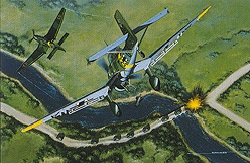|
|
| Sirens Of Death |
|
 |

|
 |
|
|
| DESCRIPTION |
 |
| 16 x 11.5 Inch Collector Size Unframed Lithograph $40.00
Ernst Udet the German WW I ace who visited America in the late twenties was so impressed with the U.S. Navy's Curtis Hawk divebombers that he ordered one for evaluation and study by German aircraft manufacturers. This led to the development of Germany's first divebomber the Henchel 123. By 1935 the German Luftwaffe was developing its first monoplane divebomber which entered production in 1936 as the Ju87 Stuka. The Stuka was to evolve into arguably the most successful single engine Axis divebomber of WW II. Utilizing a nearly vertical dive position the Stuka was stunningly accurate in the days when horizontal bombing was a relatively inaccurate science. The Ju87 was built for functionality and ruggedness. A fixed landing gear and exceptionally strong wing design were incorporated and no attempt was made to minimize protrusions. The Stuka was not designed for speed; it was an aerodynamic nightmare. The Stuka also incorporated a siren which when activated during a dive was designed to inflict psychological damage on the enemy below. The Ju87 was used with tremendous success in the Blitzkrieg attacks on Norway Poland Belgium France Holland Yugoslavia and Greece. Virtually unchallenged in the air during these Blitzkriegs the Stukas took a devastating toll on Allied ground and mechanized forces. Shipping was also vulnerable to the pinpoint attacks of the Stuka and the Ju87 destroyed more Allied shipping than all other German aircraft put together during WW II. During Hitler's air attacks on Britain the Stuka's reputation for invulnerability was shattered. Facing British Hurricanes and Spitfires the slower and less maneuverable Ju87's were destroyed in large numbers eventually forcing their withdrawal from that conflict. Germany's attempt to develop an improved twin engine divebomber resulted in the introduction of the Messerschmitt 210 which was an unmitigated disaster. As a result the Stuka remained in production longer than expected and the aircraft played a major role in Germany's surprise attack on Russia. In the first day of combat alone Stukas were credited with the destruction of over 700 Russian aircraft with minimal losses. One of Germany's top aces of WW II was Hans-Ulrich Rudel. Rudel flew over 2500 combat missions in Ju87's and was shot down on twelve occasions. Rudel was credited with destroying 519 tanks 800 vehicles 150 artillery pieces one Russian battleship one cruiser and one destroyer. Rudel was also credited with shooting down nine Russian aircraft in air-to-air combat. In his painting created exclusively for The Stokes Collection Stan Stokes captures the German ace in action on the Russian front in 1941. |
|


|